Lido di Jesolo is not the most fashionable resort in Italy, but next to it are the two most romantic cities in the world - Venice and Verona. It is for their sake worth visiting at least once in these parts.
Contents
- Where is Lido di Jesolo
- How to get to Venice and Lido di Jesolo?
- Pros and cons of resting on Lido di Jesolo
- Pros and cons of vacation in Venice. Where to stay in Venice - the center or the neighborhood?
- The main attractions of Venice
- St. Mark's Square
- St. Mark's Cathedral
- Doges Palace
- Bridge of Sighs
- Church of Santa Maria della Salute
- Museum of Correra
- Grand Canal
- Murano Island
- Burano Island
- Venice Sights
- Padua
- Verona -the capital of all lovers
- Video. Carnival in Venice
- Video. Verona and its surroundings in the clip "The Kings of the Night Verona"
- Padua, the official video of
- Video. The song of the gondolier, Venice
Where is Lido di Jesolo
Lido di Jesolo is a seaside resort on the Adriatic Sea near Venice. It is located in the very north of Italy. Lido di Jesolo is a continuous strip of wide sandy beaches with a smooth gentle beach and small towns along the coast. The resort became popular among tourists only recently - in the 60s of the last century.
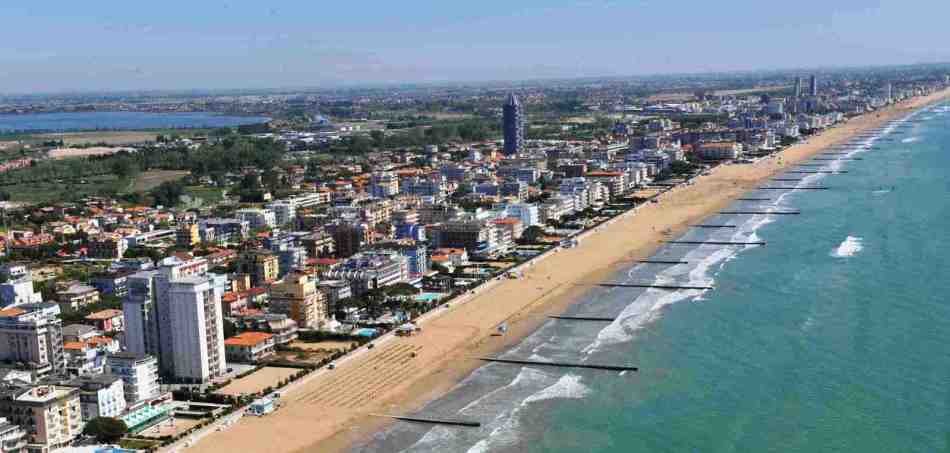 Beach strip on Lido di Jesolo, Italy
Beach strip on Lido di Jesolo, Italy Mostly families with children and those who want to combine beach holidays with visiting Venice, Verona, and the famous mountain lakes of Italy - Como and Garda - are vacationing here. The resort has several good amusement parks, a well-developed infrastructure and very democratic prices.
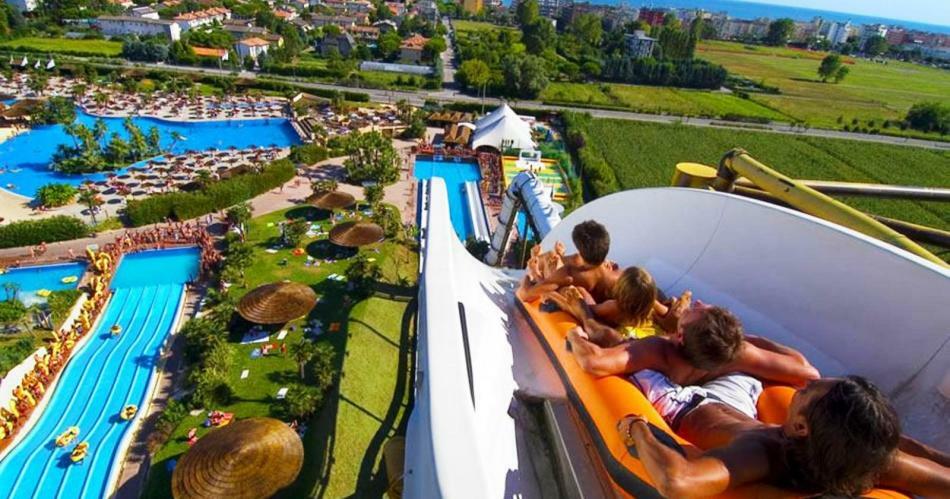 Aqualandia Park at Lido di Jesolo, Italy
Aqualandia Park at Lido di Jesolo, Italy How to get to Venice and Lido di Jesolo?
Lido di Jesolo has a well-developed transport network, local buses run along the entire coast, linking the resort with the cities of Padua, Milan, Venice and others. The easiest way to get to Lido di Jesolo from Venice. If you do not plan to visit other regions of Italy, then you should buy a direct flight to Venice( Marco Polo Airport).
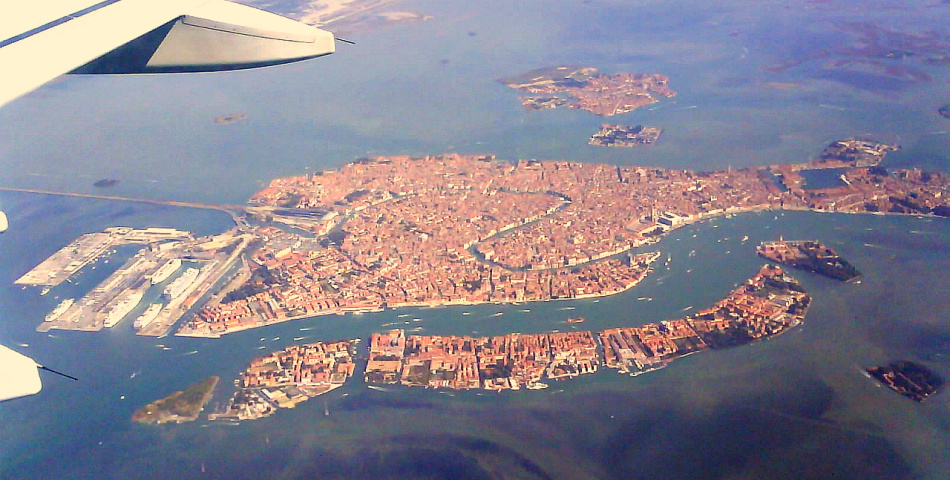 Venice from a bird's-eye view. Italy
Venice from a bird's-eye view. Italy There is a regular direct connection with Moscow, carriers Aeroflot and Alitalia. The schedule of Aeroflot flights can be viewed here. Also, Venice is associated with regular year-round flights with other European cities. You can fly to Venice from Rome and Naples, but such a flight is likely to cost you more than a direct one. A full list of airlines and routes to Venice can be found here.
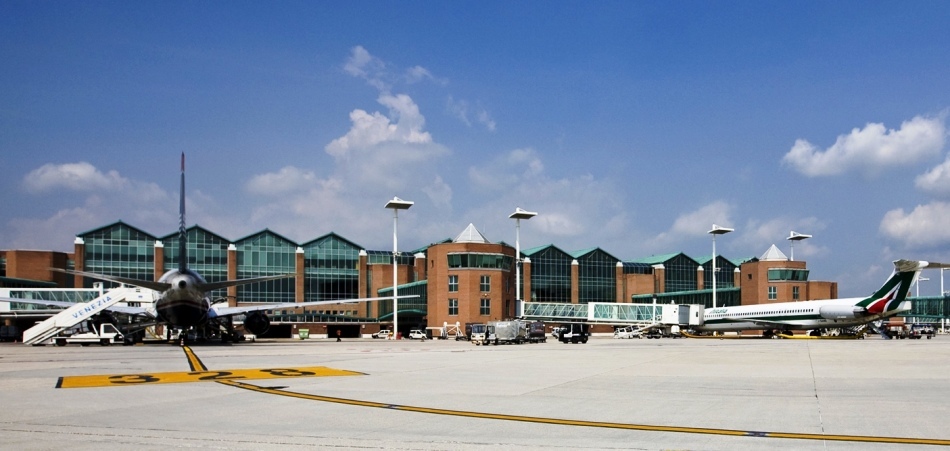 Marco Polo Airport in Venice, Italy
Marco Polo Airport in Venice, Italy From Marco Polo airport to Venice or the surrounding areas( including the coast of Lido di Jesolo), there are several ways to get there. The most simple and expensive is a taxi. You can place an order directly at the airport on special racks or call the phone number indicated here, however, in this case you should have a great command of English.
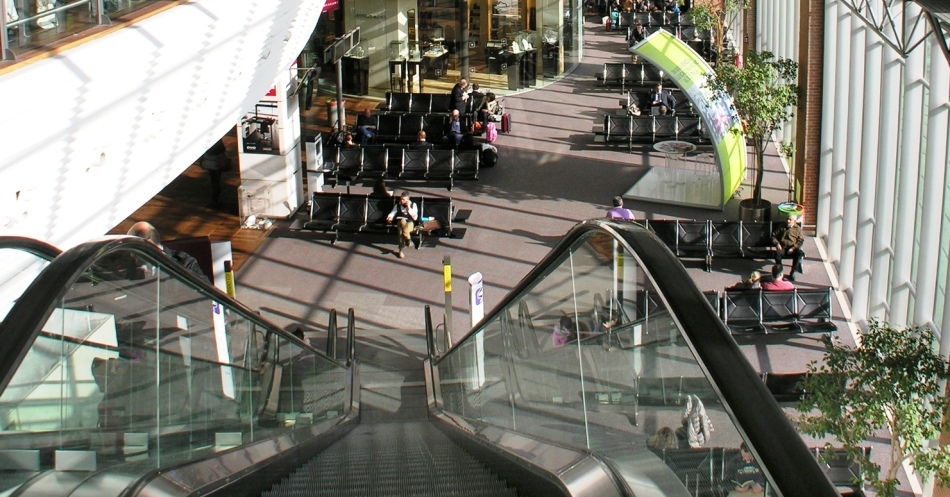 Waiting room at the airport of Marco Polo, Venice. Italy
Waiting room at the airport of Marco Polo, Venice. Italy There is a bus service. You can get to Venice itself, Lido di Jesolo, Lignano, Bibione and the Dolomites. A detailed timetable can be found here. Tickets can be bought at special kiosks and offices directly in the airport building, or from the bus driver( not on all routes).
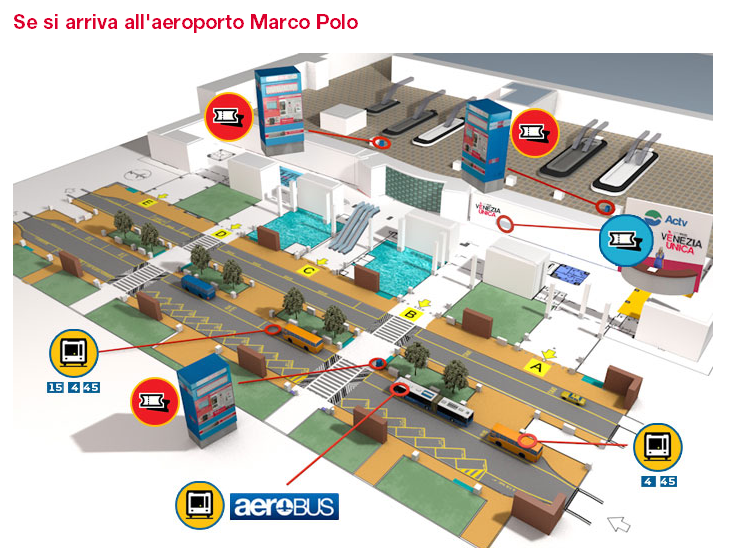 Map of ticket stalls and ticket sale machines at Venice Marco Polo Airport
Map of ticket stalls and ticket sale machines at Venice Marco Polo Airport Another type of transport is a waterbus. On it you will reach Venice or its skeletons of Murano, Burano and Lido. The ticket can be bought at the boat station or directly on board the water bus.
To find the station, you need to exit the arrival hall through the central door, on the left you will see a long covered passage, along which you will reach directly to the pier. There you will find a lot of small private companies that provide water taxi services.
 Water bus from Venice, Italy
Water bus from Venice, Italy If you want, you can rent a car right at the airport. If you are planning to relax directly in Venice or on its islands, then there is no need for a car, since Venice is a pedestrian town, and cars are of little use to you.
If you are going to the coast of Lido di Jesolo and plan not only beach, but also active excursion vacation, then it makes sense to think about renting a car.
 Bus at Venice airport Marco Polo, Italy
Bus at Venice airport Marco Polo, Italy Pros and cons of holidays at Lido di Jesolo
Lido di Jesolo is a typical beach resort. This is a solid band of hotels, beaches and all kinds of entertainment for tourists. Here you will not find historical quarters and quiet romantic places.
Rest here rather resembles the Black Sea coast in the height of summer: the carcasses of tourists on the beach, sleepy tourists, children's screeching and other joyous vacation vacations.
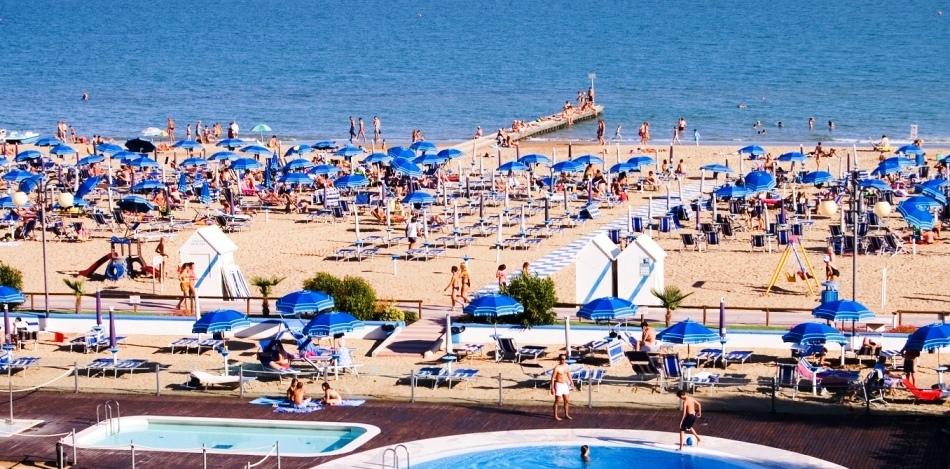 Beach on Lido di Jesolo, Italy
Beach on Lido di Jesolo, Italy But from Lido di Jesolo it's very close to Venice, Verona, the Dolomites and Lake Garda. If desired, you can quickly reach Padua, Florence and Milan, swim to Croatia or San Marino( only 150-170 km by ferry).
 Quay in Lido di Jesolo, Italy
Quay in Lido di Jesolo, Italy Prices for Lido di Jesolo do not bite. Rest here can be called economical in comparison with other regions of Italy. If you are accustomed to a premium vacation, Lido Di Jesolo is not your option, Venice or Lido Island itself is more suitable for you( see below).But those who are ready for a moderate level of service for affordable money, Lido di Jesolo fits perfectly.
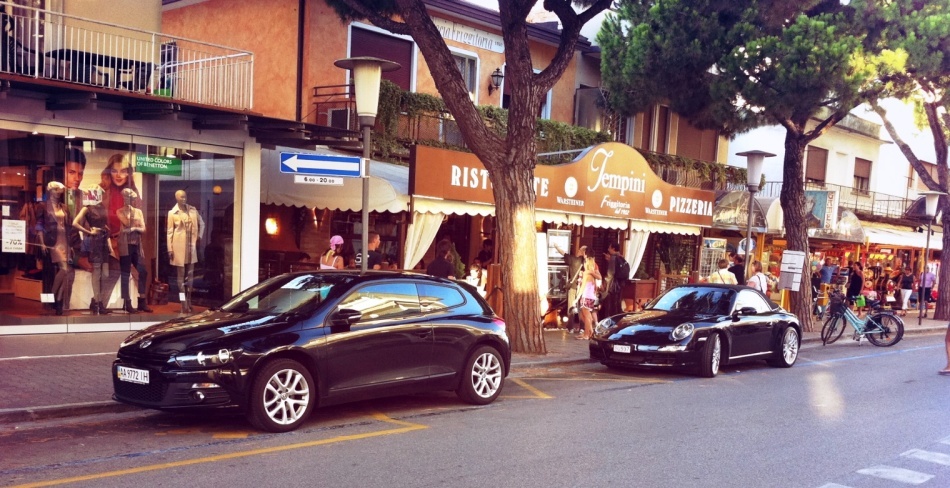 Street in Lido di Jesolo, Italy
Street in Lido di Jesolo, Italy An important feature of Lido di Jesolo is a very short summer season. Unlike other beach areas in Italy, in May and September, Lido di Jesolo can be pretty cool, often it rains and the wind blows.
In June, more sunny days, but sometimes there are cold snaps, especially at the beginning. The most suitable for a summer beach holiday months - July and September. It was at this time at Lido di Jesolo the most comfortable temperature of water and air, but for these same months there is a peak in the influx of tourists.
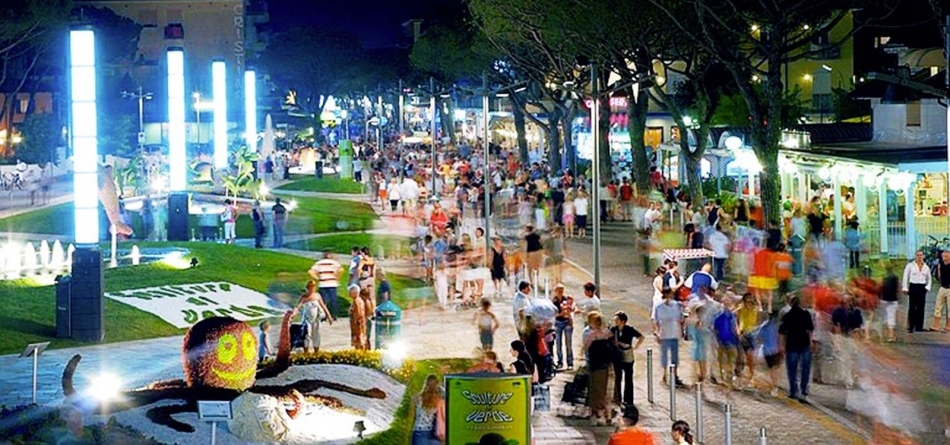 Lido di Jesolo at night, Italy
Lido di Jesolo at night, Italy Pros and cons of vacation in Venice. Where to stay in Venice - the center or the neighborhood?
You can stop directly in Venice, if you are planning only a sightseeing vacation, or combine your trip so that you can spend a few days in Venice and then go to the coast.
Two or three nights spent directly in Venice, will allow you to see something that you never see during a formal sightseeing tour.
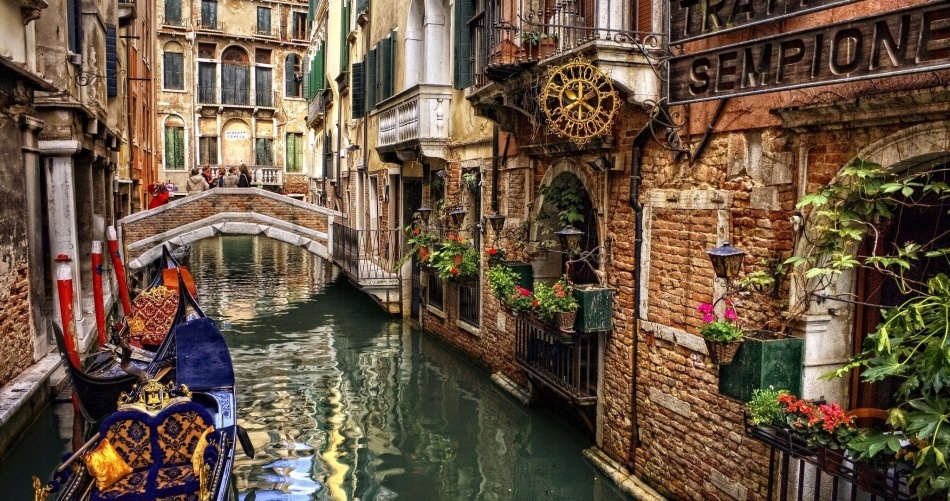 Venice, Italy
Venice, Italy The number of architectural masterpieces of Venice is one of the first places in the world. Historical buildings and quarters are in excellent condition, so you will see Venice exactly as it was seen by Petrarch and Goethe, Casanova and Princess Tarakanova, Gumilev, Bunin, and many others.
And, Venice in the afternoon and Venice at night looks like two completely different cities. In the daytime it is a bright and dynamic city filled with the sounds of street trading, the splash of gondoliers' oars, the noise of the crowd. It seems that this is not a city, but an anthill in which the movement does not cease for a minute.
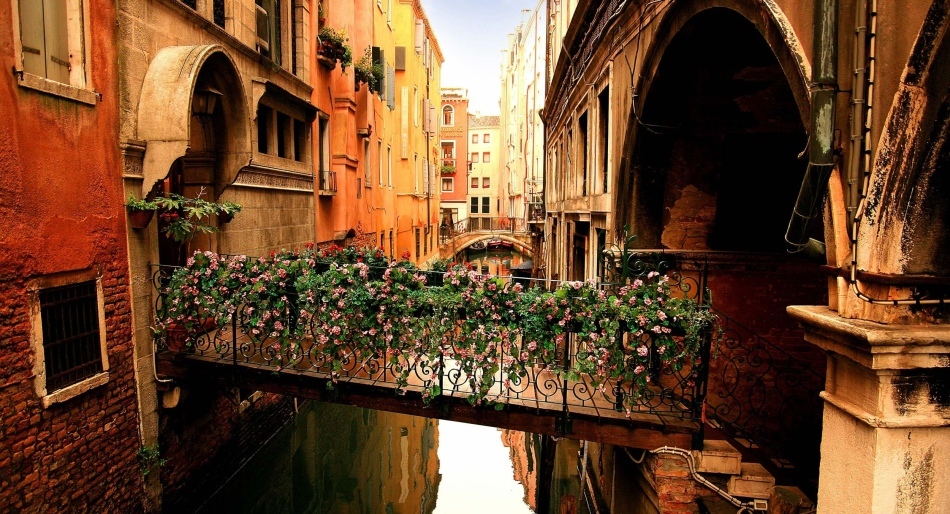 Venice Street Italy
Venice Street Italy At night, Venice seems mysterious and mysterious. Street illumination, the reflection of numerous lights in the canals, the washed out boundaries of the embankments create a sense of loss in space, everything becomes unsteady and floating. The atmosphere of day-to-day vanity in numerous cafes and on the embankments changes to romance and lazy fatigue.
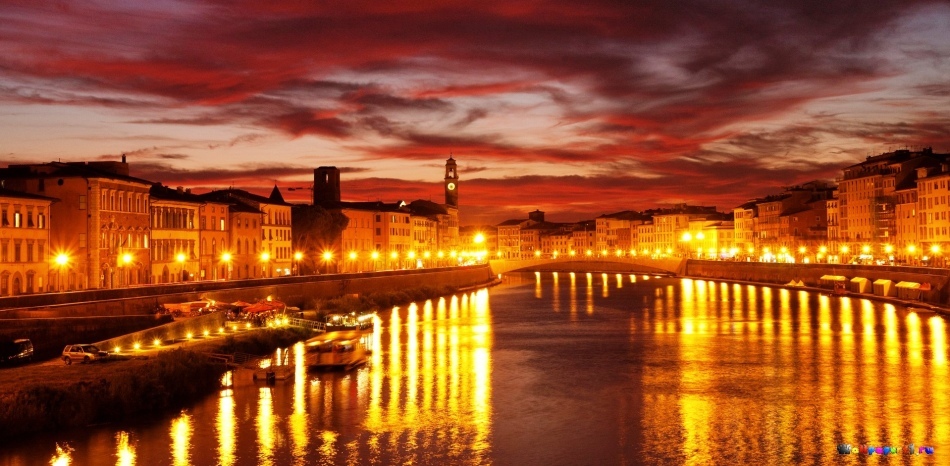 Night Venice, Italy
Night Venice, Italy It should be noted that Venice is one of the most expensive places for recreation. The cost of living, dining in a restaurant or driving through the center by transport here will be times more expensive than in neighboring cities.
If you want you can find places for food and options for travel at a relatively inexpensive price, but there you are waiting for the indispensable queues and not too comfortable conditions, so that the price-quality ratio still has a feeling that you have overpaid for service.
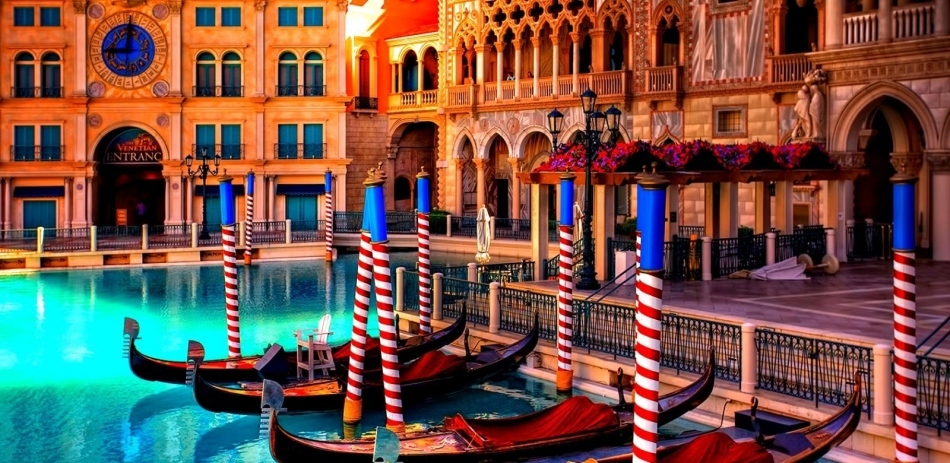 Berth in Venice, Italy
Berth in Venice, Italy  Entrance to the hotel Danieli, Venice, Italy
Entrance to the hotel Danieli, Venice, Italy But you have to put up with the smell of dampness in the rooms, the scents of flowering water in the canals( this phenomenon occurs periodically, especially in spring and early summer), and the crampedness of pedestrian sidewalks.
On a stifling night, you are unlikely to open the window in your hotel room. In addition, sometimes the houses are so close to each other that leaving the windows open is simply not comfortable.
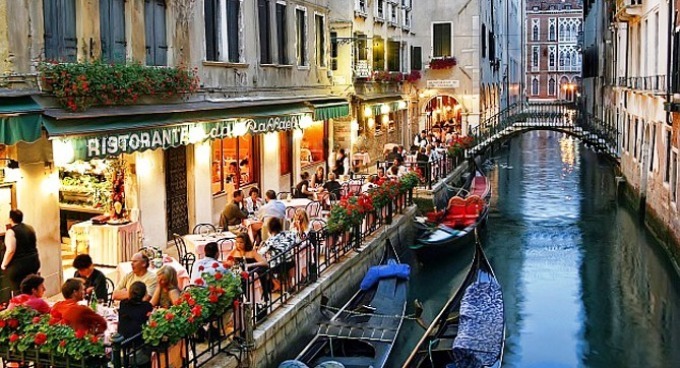 A street restaurant in Venice Italy
A street restaurant in Venice Italy At the height of the tourist season, Venice can look pretty dirty. Because of the influx of tourists, urban services simply do not have time to put things in order( however, this remark is typical for all Italian cities, so garbage can be considered a local feature and not bother with this issue.)
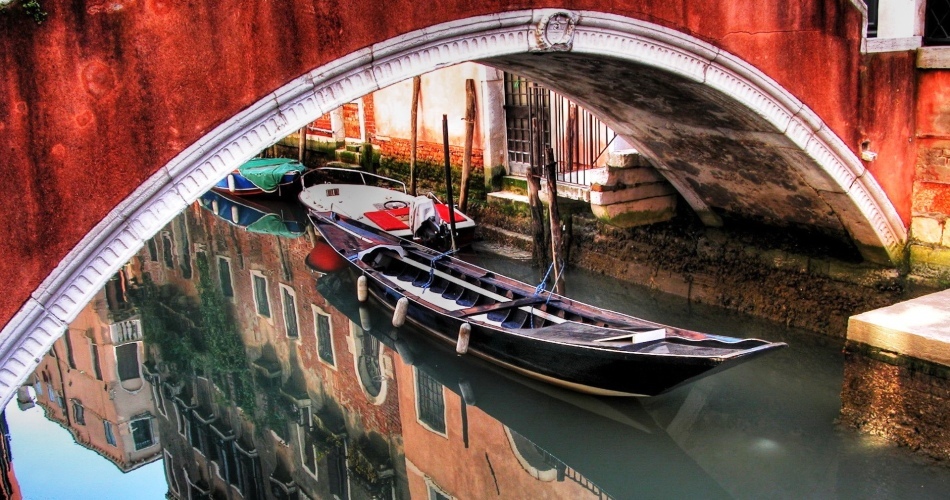 Canal in Venice, Italy
Canal in Venice, Italy Despite all of the above, Venice is definitely worth seeing once in a lifetime. No small things and everyday inconveniences are not capable to spoil its charm and beauty.
If you want to combine beach holidays with frequent sightseeing, you can stay on the island of Lido - here you will find beautiful sandy beaches, excellent boarding, and the center of Venice at any time can be reached in just 20 minutes by speed boat.
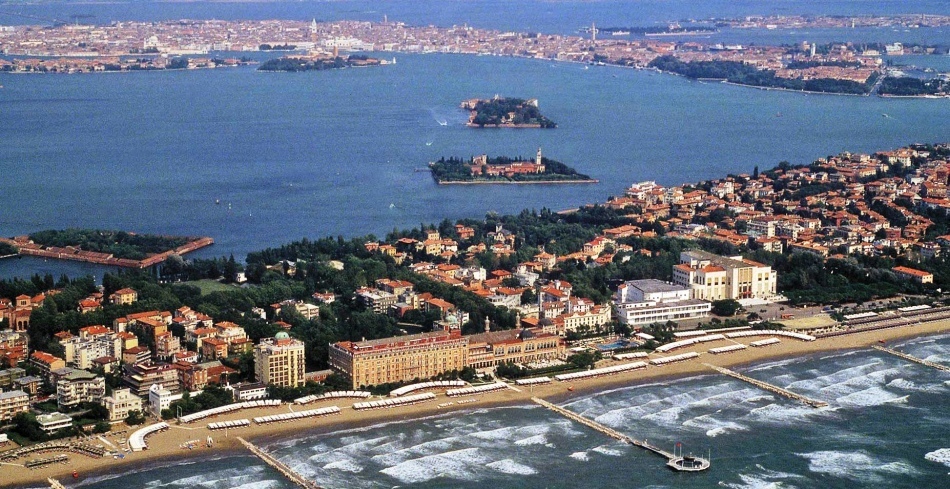 Lido di Venezia Italy
Lido di Venezia Italy Lidos like to relax celebrities and local wealthy citizens. During the Venice Film Festival( in September), most of the guests and festival stars live here, so it is simply not feasible to book anything for living in the early autumn of Lido - all the local hotels traditionally leave places for visiting celebrities.
And the rest during the festival can not be called comfortable - the prices here soar to the skies, many cafes and restaurants are closed for individual service.
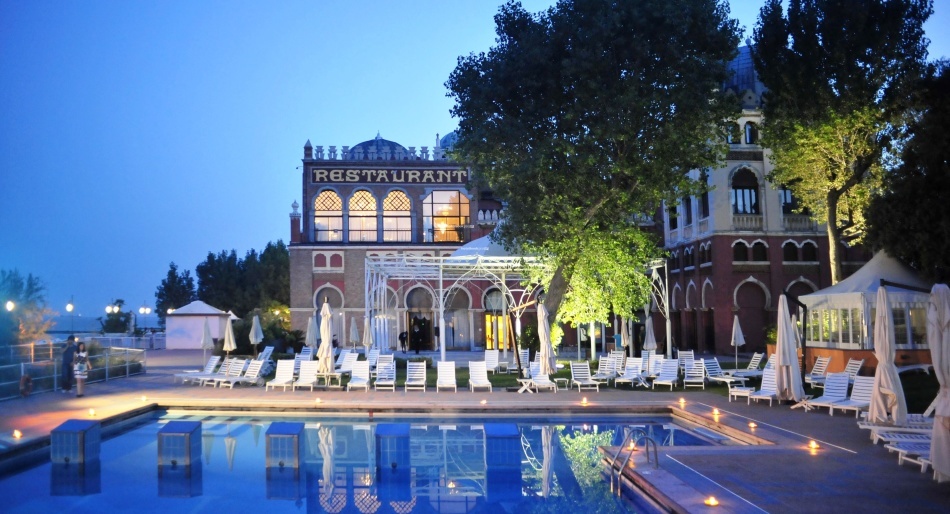 Hotel Excelsior, Lido Island, Venice, Italy
Hotel Excelsior, Lido Island, Venice, Italy The main attractions of Venice
St. Mark's Square
San Marco is the central square of the city. The remaining areas of Venice are called campo and campiello( glades and fields).San Marco can be called a visiting card of Venice. The square acquired its modern appearance in the 17th century, but some buildings are much older.
For example, the pavement was laid out in the XIII century, and the clock tower was built at the end of the XV century.
Napoleon called the Piazza San Marco "the living room of all Europe".By the number of attractions, St. Mark's Square is the main place in the city.
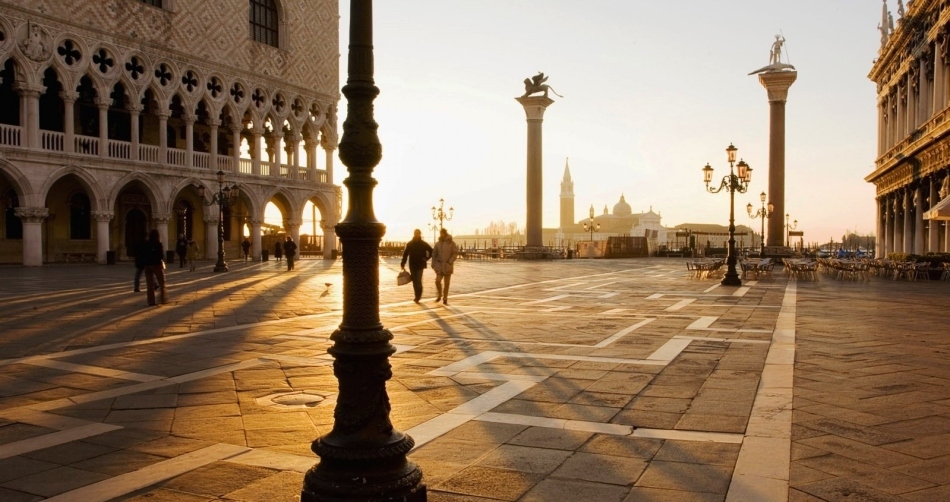 St. Mark's Square, Venice, Italy
St. Mark's Square, Venice, Italy St. Mark's Cathedral
The Cathedral of San Marco is the main cathedral of Venice. It was laid in the X century, when the Venetians literally stole from Egypt the relics of St. Mark and decided to build a separate temple for their storage.
Act of course, unseemly, but the goal was noble - to save sacred Christian relics from the hands of gentiles, Saracens Muslims, who at that time owned Alexandria.
In general, I must say that in the Middle Ages, European city-states actively practiced the theft of the relics of various saints, in order to save them from destruction, and at the same time raise the status of their city in the eyes of other Christians and the Roman Church.
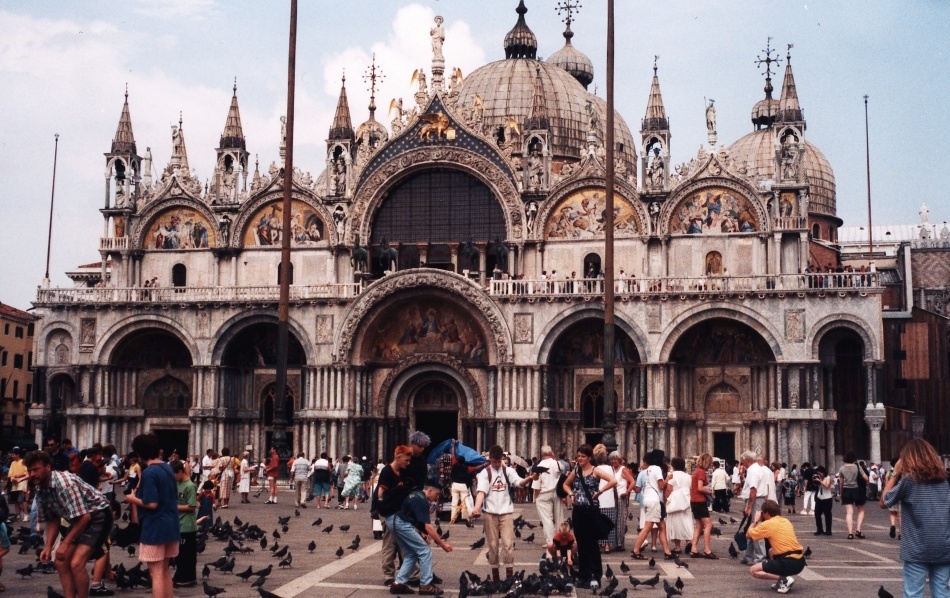 St. Mark's Cathedral in Venice, Italy
St. Mark's Cathedral in Venice, Italy St. Mark's Cathedral for many centuries served as a starting point for the Crusades. It crowned the Venetian doges and passed historical( by the standards of Venice) mass.
On the square in front of the Cathedral were the main festivities and festivities of the Venetian Republic, including the famous Venetian carnival. By the beauty and richness of interior interiors, the cathedral fully justifies its status.
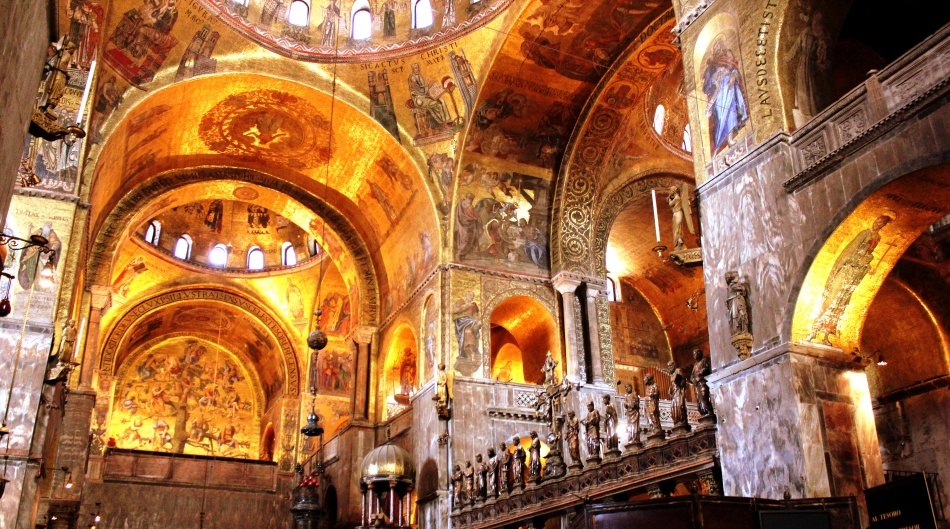 Interior of the Basilica of San Marco in Venice Italy
Interior of the Basilica of San Marco in Venice Italy The Cathedral of San Marco was originally built as the main church of the city, so the best architects of the time were involved in the construction, including Byzantine architects, who in the early Middle Ages were not equal in skill.
San Marco was erected in the image and likeness of the Hagia Sophia in Constantinople. True, in subsequent centuries it was expanded several times and completed, but the basic elements of the Byzantine style are clearly visible even now.
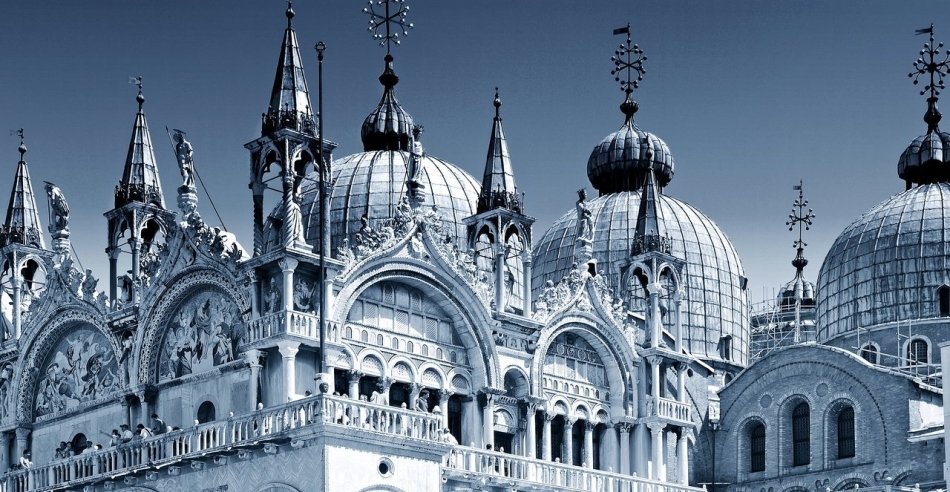 The domes of St. Mark's cathedral, Venice, Italy
The domes of St. Mark's cathedral, Venice, Italy The main altar of the Cathedral of St. Mark, in which the relics of St. Mark is stored, is covered with gilding and precious stones, and its frame is made of silver, decorated with enamel and inlays.
There are so many marbles, gilding, precious and semiprecious stones in the interior of the temple that the Cathedral of San Marco used to be called "golden", and because of its richness of design, it was not equal in Europe.
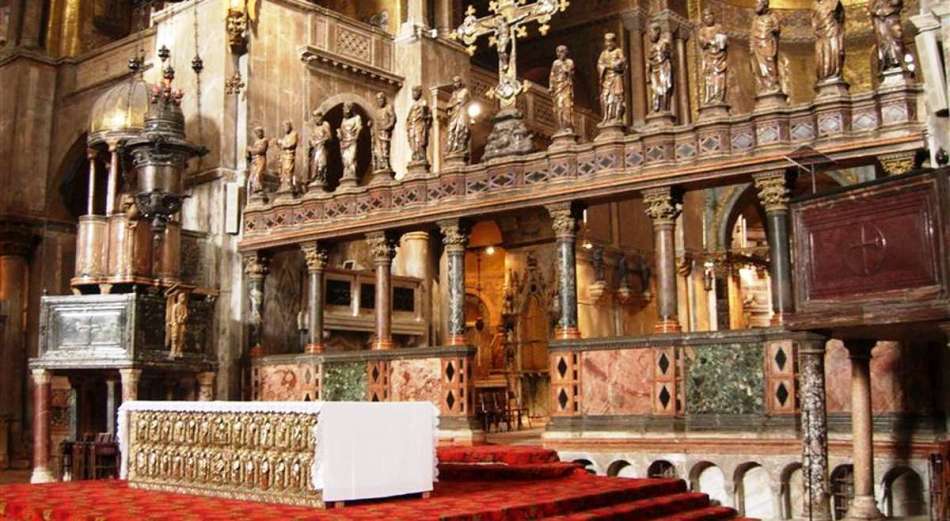 The main altar of St. Mark's Basilica, Venice, Italy
The main altar of St. Mark's Basilica, Venice, Italy Doges 'Palace
The Doges' Palace is the residence of the Venetian rulers and one of the most recognizable buildings of Venice. In its architecture, the Gothic and Moorish style is so skillfully intertwined that the building, despite its strict geometric contours and rather impressive dimensions, seems to float above the embankment.
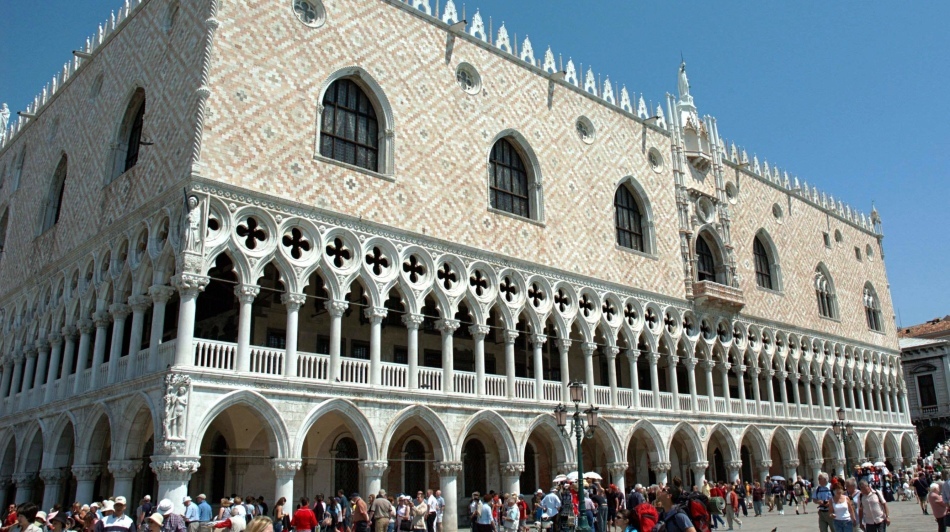 Doges' Palace, Venice, Italy
Doges' Palace, Venice, Italy Like the St. Mark's Cathedral, the Doge's Palace was built in such a way that the power and might of the Venetian Republic were visible in everything. There are also a lot of gilding and marble, everywhere you can see the figures of a winged lion - the symbol of St. Mark, the patron saint of Venice.
The walls are decorated with frescoes by Titian, Veronese and Tintoretto, as well as paintings by Hieronymus Bosch. Here is stored a unique map of the world of the famous Venetian Marco Polo, on which the territory of modern Russia is designated as the Great Tartary, stretching from the Pacific Ocean to the Caspian Sea.
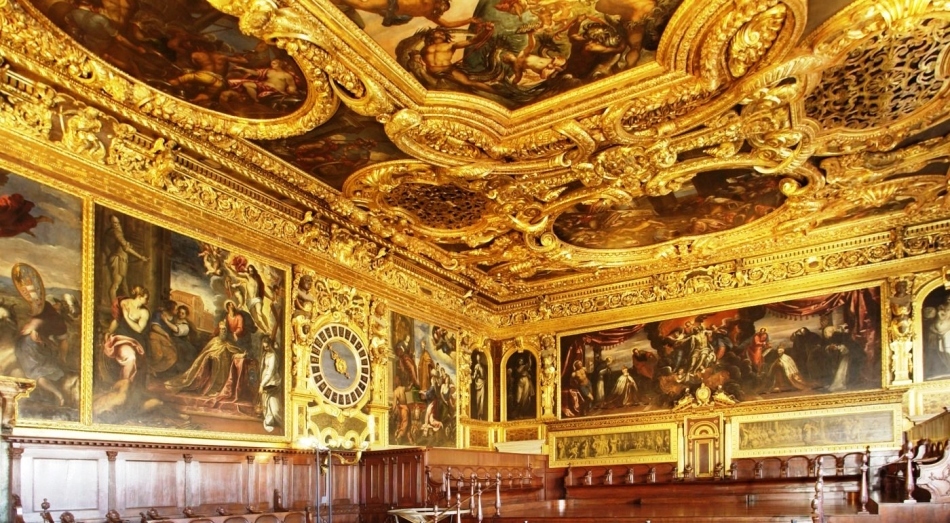 The Doges' Palace, Venice, Italy
The Doges' Palace, Venice, Italy In addition to the parade hall in the Doge's Palace, there are secret rooms - premises for torture and detention of state criminals, who in the Middle Ages were judged and interrogated by the "council of ten" - a Venetian analogue of the Court of the Holy Inquisition.
Among others among the prisoners of secret rooms are Giordano Bruno, burned by the Inquisition at the stake, and the famous Casanova - incidentally, the only prisoner who managed to escape from detention;before him the escape from the prisons of the Doge's Palace was considered impossible.
 Prison in the Doge's Palace, Venice, Italy
Prison in the Doge's Palace, Venice, Italy Excursions to the Doge's Palace can be ordered here. The Doge's Palace is open for visitors all year round from 8:30 to 19:00( from November to the end of March, the work time is reduced to 17:30), cash desks are closed an hour earlier. In the Catholic Christmas and New Year( December 25 and January 1) the Palace is closed to visitors.
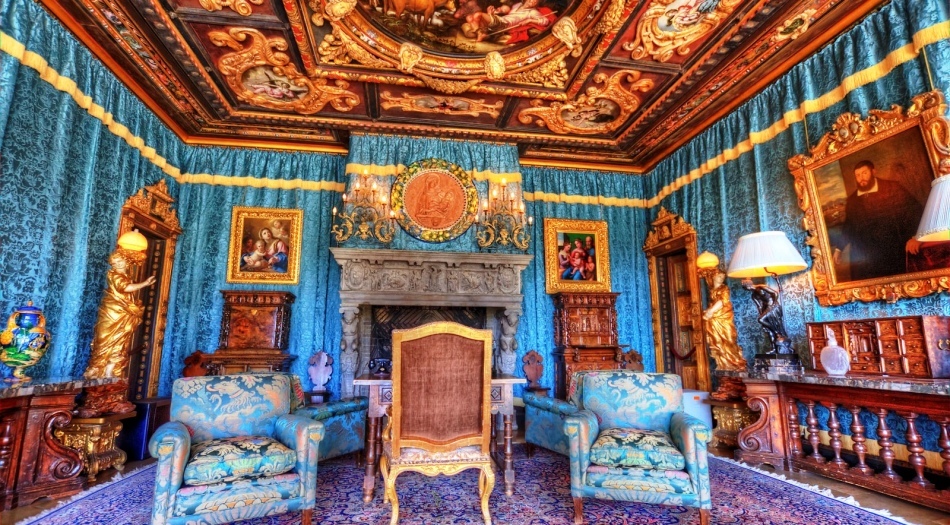 Inner rooms of the Doge's Palace, Venice, Italy
Inner rooms of the Doge's Palace, Venice, Italy Bridge of Sighs
Despite the beautiful name, the Bridge of Sighs has a rather sad story. The bridge connects the Doge's Palace with the premises of the former casemate. After the trial, the prisoners sentenced to detention were escorted to the cells precisely along this bridge.
Here, the prisoners could have looked at the window for the last time to the sunshine, as the conditions in the local prison were so severe that almost none of the prisoners survived until the end of their term.
Therefore, with a farewell glance at Venice, the unfortunates issued a deep, sad sigh. They say that here still you can hear the sighs of the unfortunate, who said goodbye to their lives many centuries ago.
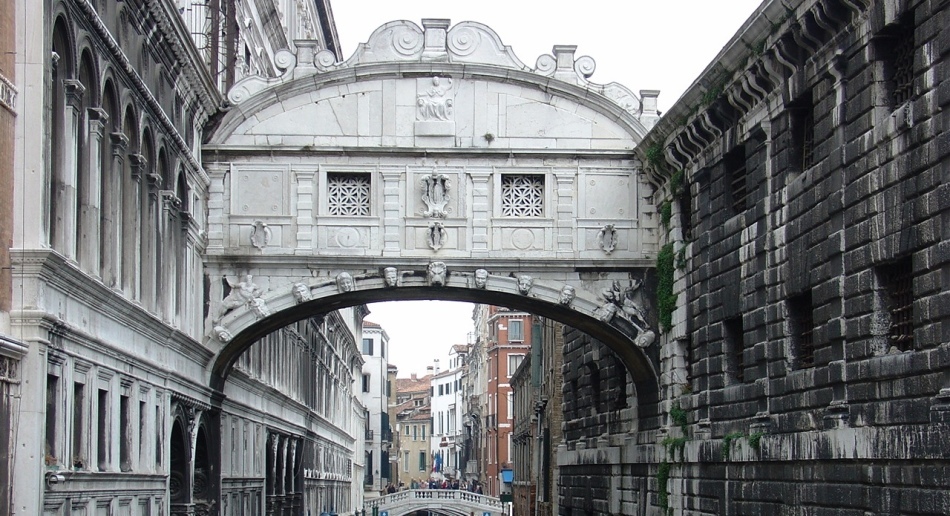 Bridge of Sighs, Venice, Italy
Bridge of Sighs, Venice, Italy Nowadays the sad history of the bridge is somewhat brightened by a new, more romantic legend. It is believed that the kiss of lovers on the bridge at midnight will make their love able to overcome any obstacles.
And if you merge into a kiss, swim under the bridge, then lovers will certainly marry and live a long happy life in marriage. In the evenings, on the canal leading to the Bridge of Sighs, a huge line of gondolas is built, in which the lovers sit.
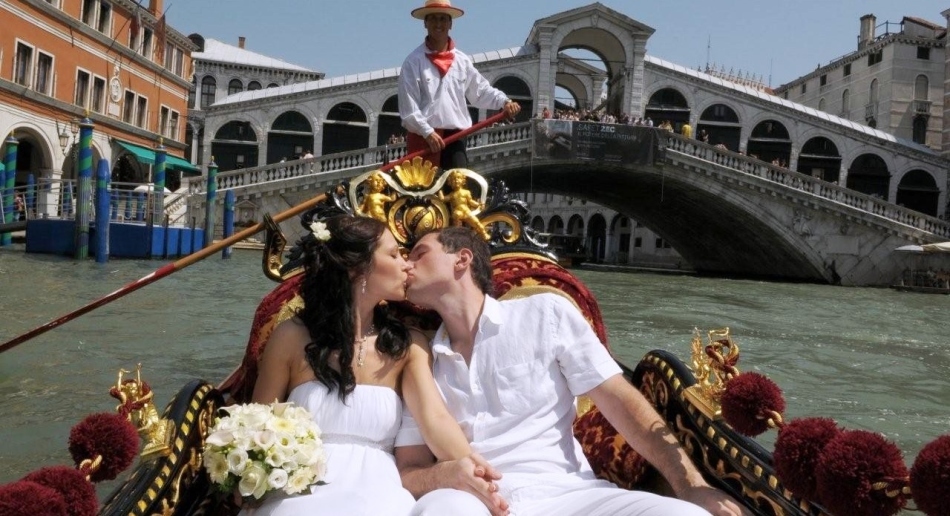 Wedding photosession near the Bridge of Sighs, Venice, Italy
Wedding photosession near the Bridge of Sighs, Venice, Italy Church of Santa Maria della Salute
Santa Maria della Salute is located opposite the Doge's Palace. In the people it is called "plague", since it was built in honor of the city's deliverance from the plague, which in the 17th century carried away a third of the population of Venice. The name of the church is translated as St. Mary the Healing.
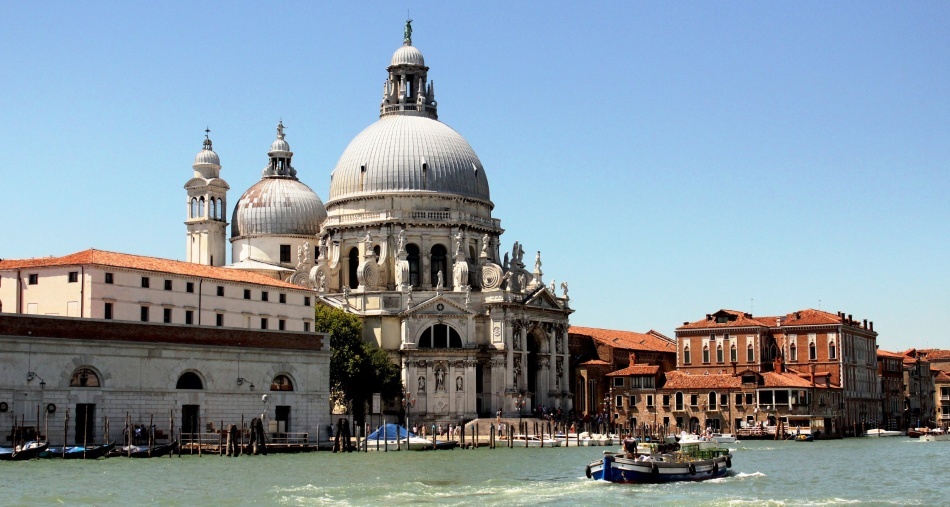 Church of Santa Maria della Salute, Venice, Italy
Church of Santa Maria della Salute, Venice, Italy The church was erected for more than half a century - the building was designed so grandiose that the builders could not strengthen the foundation, sufficient to withstand the massive construction of the church.
As a result, more than one hundred thousand beams from valuable tree species were used to erect the foundation. Taking into account the luxurious interior decoration, the construction of the temple cost the city a very round sum.
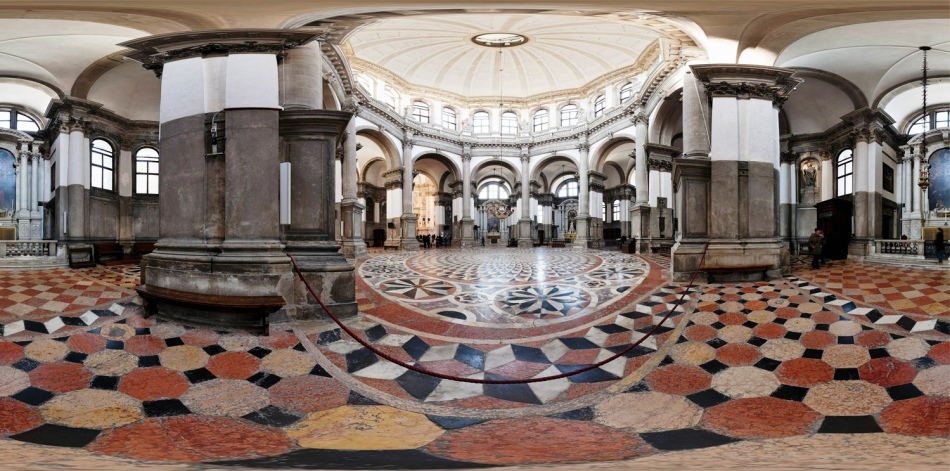 Interior of the Church of Santa Maria della Salute, Venice, Italy
Interior of the Church of Santa Maria della Salute, Venice, Italy Every year on November 21, on the Catholic day of the Blessed Virgin, a kind of floating bridge is built from tightly fitted gondolas, through which locals arrange a procession from St. Mark's Square to the church in honor of the miraculousgetting rid of the epidemic.
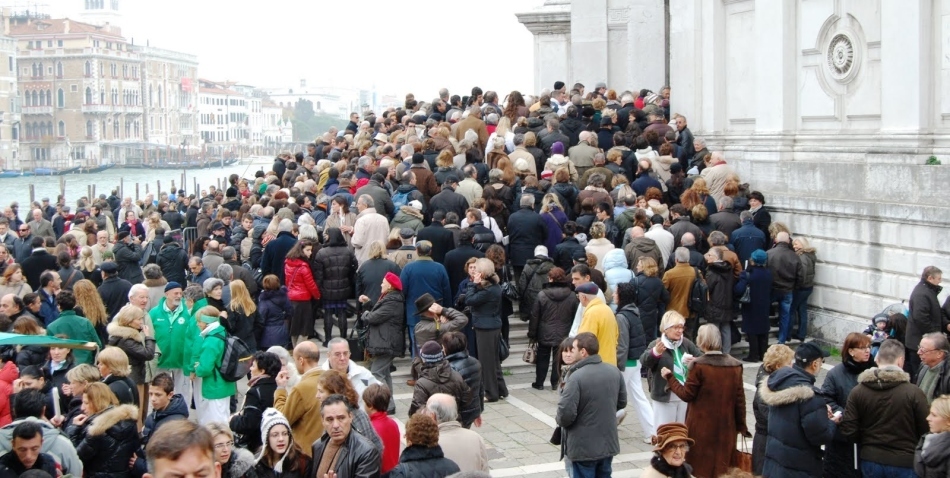 Celebrating the Day of the Blessed Virgin Mary in Santa Maria della Salute, Venice, Italy
Celebrating the Day of the Blessed Virgin Mary in Santa Maria della Salute, Venice, Italy Correr Museum
The Correr Museum is a private art collection of the Venetian Theodoro Correro, which he bequeathed to his city in 1830 after his death. The collection is a rich treasury of works of art, antiques and art paintings.
Together in the collection Correr bequeathed and the ancient palace of San Zang Degola. Subsequently, the exhibition was expanded by donations of valuable items from other townspeople and monasteries.
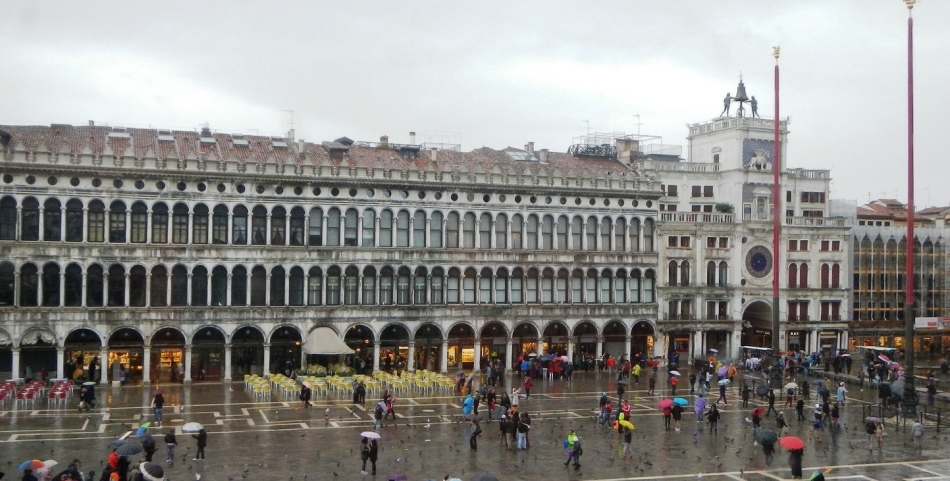 Carrer Museum, Venice, Italy
Carrer Museum, Venice, Italy In the 19th century, a separate building was built under the Museum of Correr in the San Marco square. For today the exposition of the museum is one of the most impressive in the world.
The museum has many themed halls, including an exposition of Venetian costumes, an art gallery with the works of Titian, Durer, Bellini and others, the history of the Venetian Republic, a collection of weapons and armor, and much more.
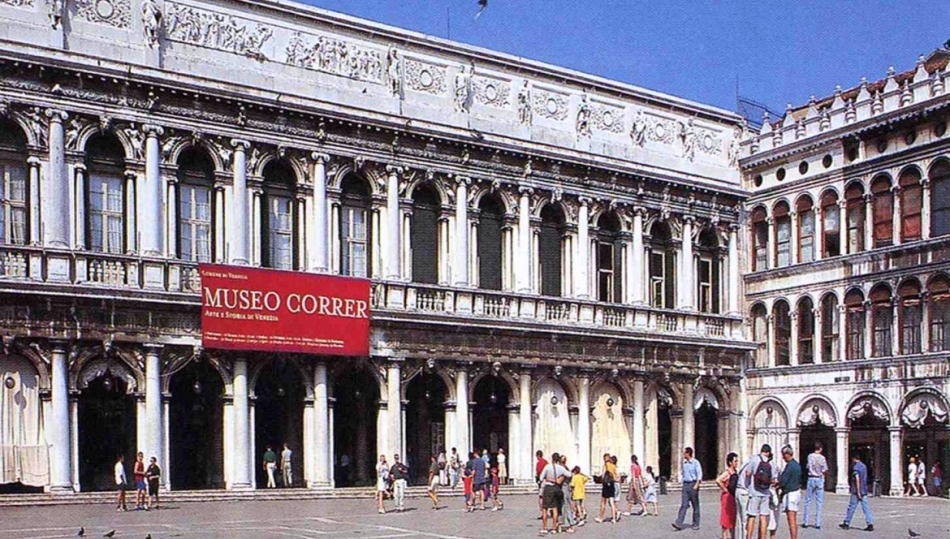 Entrance to the Museum of Correra, Venice, Italy
Entrance to the Museum of Correra, Venice, Italy The museum is open from 10:00 to 19:00( in the winter before 18:00), ticket offices close an hour earlier. Admission fee for adults is 16 euros. Discounts are provided for pensioners, schoolchildren and students. To buy tickets, as well as more information about the museum's exposition, click here.
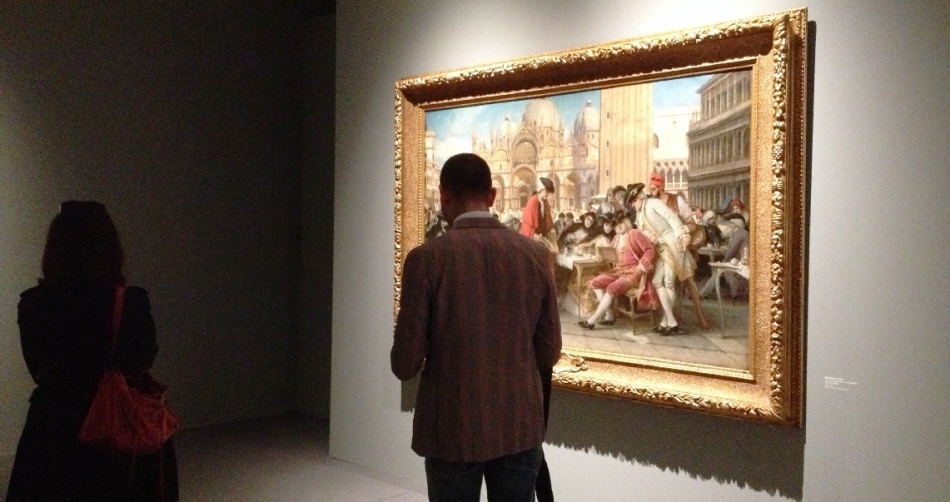 The work of Francesco Guardi at the Carrera Museum, Venice, Italy
The work of Francesco Guardi at the Carrera Museum, Venice, Italy Grand Canal( Grand Canal)
The Grand Canal is, one might say, the "main street" of Venice. A walk through the Grand Canal is included in the obligatory excursion list when visiting the city. The buildings, built along the banks of the canal, date from the 12th-17th centuries.
For the most part, these are the houses of the most famous and wealthy townspeople, therefore it is on the banks of the Grand Canal that the largest number of palaces is concentrated.
 Grand Canal, Venice, Italy
Grand Canal, Venice, Italy To see the Grand Canal in all its splendor, it is worth taking a gondola. Pleasure is not cheap, but it's unforgivable to go to Venice to not ride a gondola. Note that many gondoliers are not just carriers.
There are real "showmen" among them who will give you a short excursion during the voyage, tell interesting facts about the history, sing a couple of songs and certainly tell at least one of the local legends. So when choosing a gondola, choose the driver more robust - you will not regret it.
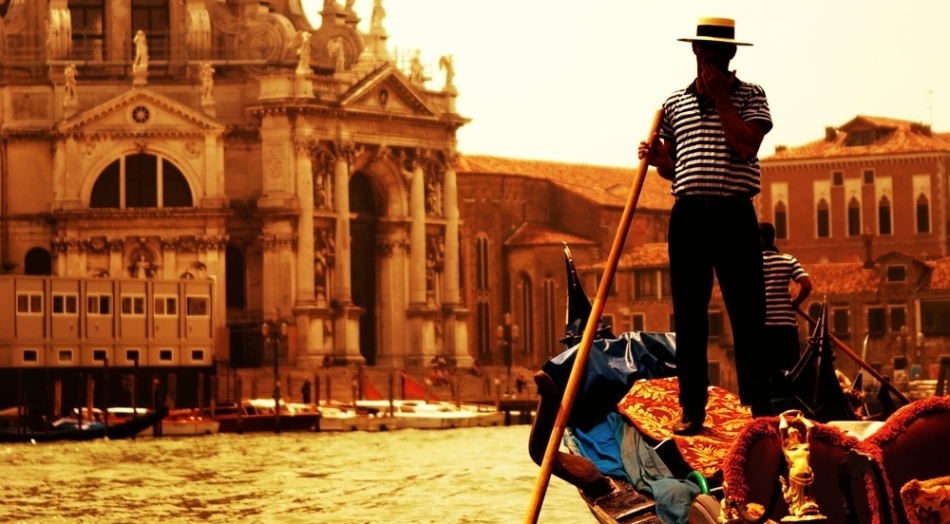 Gondoliers on the Grand Canal, Venice, Italy
Gondoliers on the Grand Canal, Venice, Italy Murano Island
Murano is one of the island regions of Venice, on which the museum of the famous Murano glass is located. Since the XII century, it was this island that was assigned to the workshops of glass blowers, as the production of glass was extremely fire hazardous. To protect the city from accidental fires, all glass blowers had to do their craft here.
 The process of manufacturing Murano glass, Venice, Italy
The process of manufacturing Murano glass, Venice, Italy The island has a museum of the history of making Murano glass. The museum is open every day, except Wednesday. More information about the schedule of work and the exposition of the museum can be found here. In numerous handicraft shops on the island and in the store at the museum you can find amazing beauty handmade products from Murano glass.
 Murano Glass Decoration, Venice, Italy
Murano Glass Decoration, Venice, Italy Burano Island
With its lace makers, Venice has become famous since the 16th century. It is believed that the skill of weaving lace local fishermen have mastered by making networks for their husbands. Venetian lace was so highly valued in Europe that they were ordered by the best royal houses to decorate the ceremonial clothes of the monarchs.
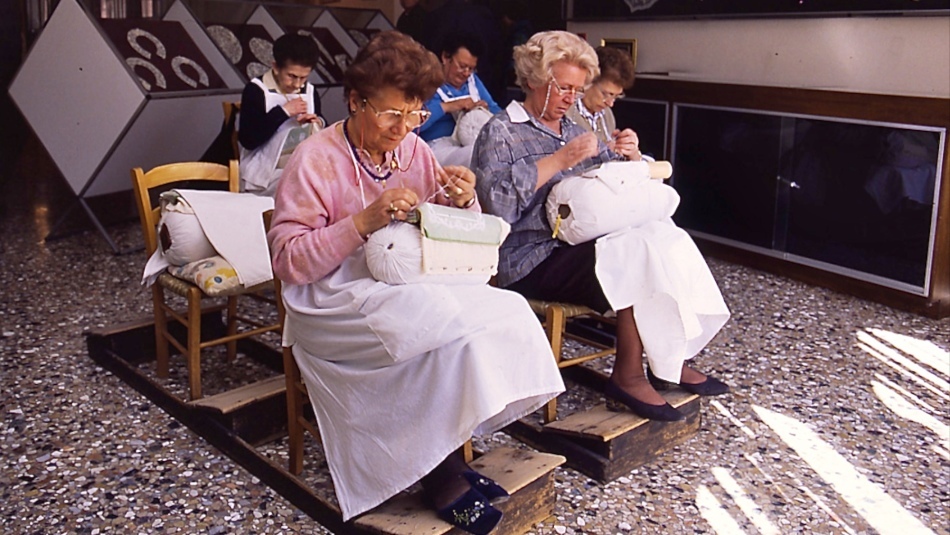 Masters of Burano at work, Venice, Italy
Masters of Burano at work, Venice, Italy On Burano, it's worth to go for two reasons. First, for the purchase of unique handmade lace products( from the laces of the handyman of Burano weave not only napkins and tablecloths, you will find exclusive wardrobe items, evening dresses, stoles, wall panels, curtains, etc. And believe me, jackets and dresses of local mastersthey will envy any fashion houses, it's not for you "grandmother's joys."
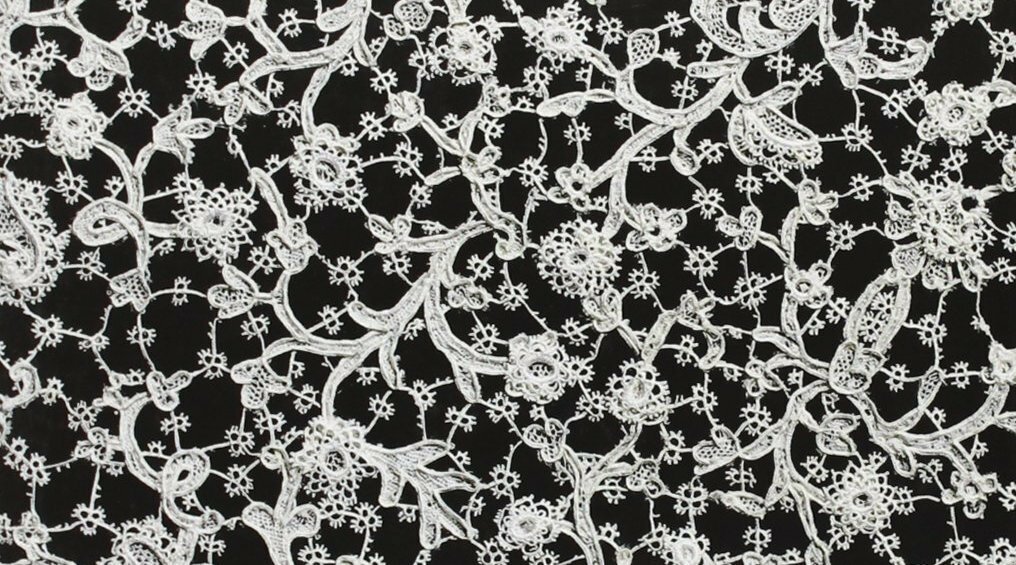 Lace from Burano Island, Venice, Italy
Lace from Burano Island, Venice, Italy Secondly, a walk along the narrow streets of Burano is a special pleasure. All the houses here are painted in bright festive colors.diction began several centuries ago when the sailors at the entrance to the harbor searched for the road to the house, being guided by its coloring. Now there is no need for this, but local residents jealously revere this rule.
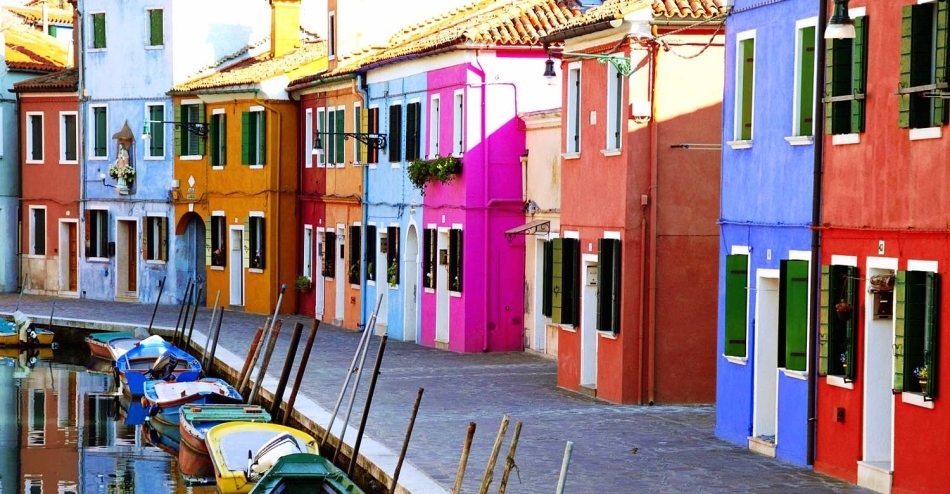 Colorful houses on the island of Burano, Venice, Italy
Colorful houses on the island of Burano, Venice, Italy And the local municipalityeven can fined the owner of the house for an inappropriately bright coloring. Another interesting point: you can paint the house not anyhow, but in strict accordance with the color palette approved by the municipality.
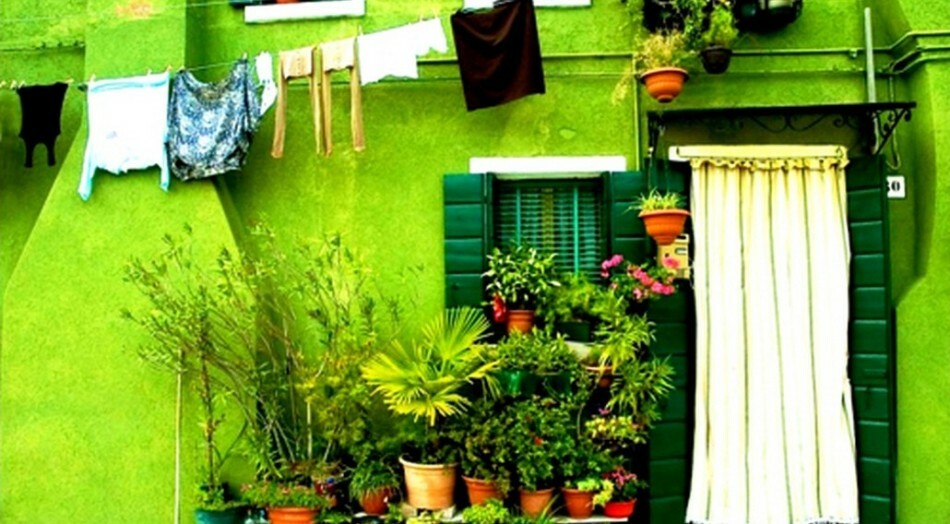 Burano Island, Venice, Italy
Burano Island, Venice, Italy Sights of Venice
Quarter of Castello is the largest district in Venice where the Doge's Tomb is located, the Biennale Museum of Contemporary Art, the majestic Renaissance Saint-Dzacary Church, the Campo San Zaccaria Square,a few centuries ago, was the refuge of the most notorious criminals( here and to this day operates a medieval prohibition to build new homes and settle in new families, so as not to multiply crime).
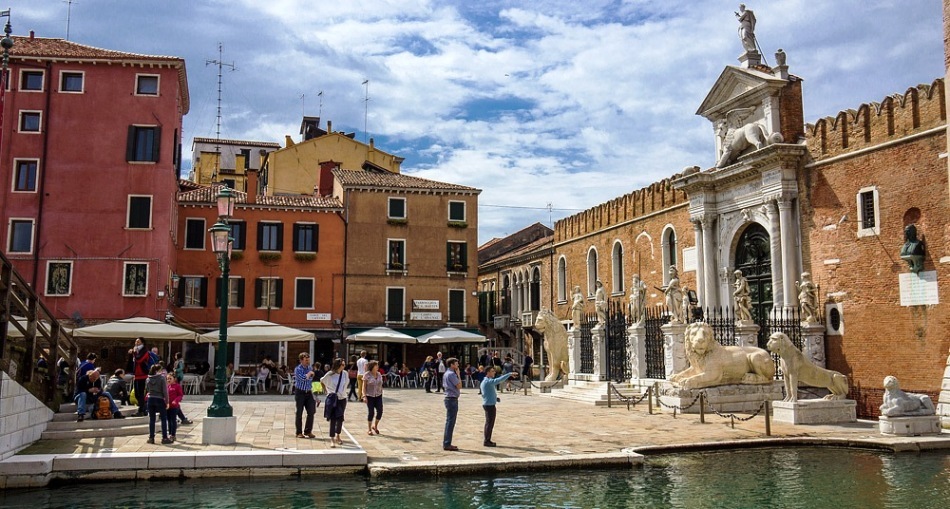 Quarter of Castello in Venice, Italy
Quarter of Castello in Venice, Italy The island of Torcello is the oldest part of the city from where Venice originates. Among the local attractions you can mention the throne of Atilla, an old bridge without railings( such were built in Venice in the early Middle Ages), the ancient church of Santa Fosca.
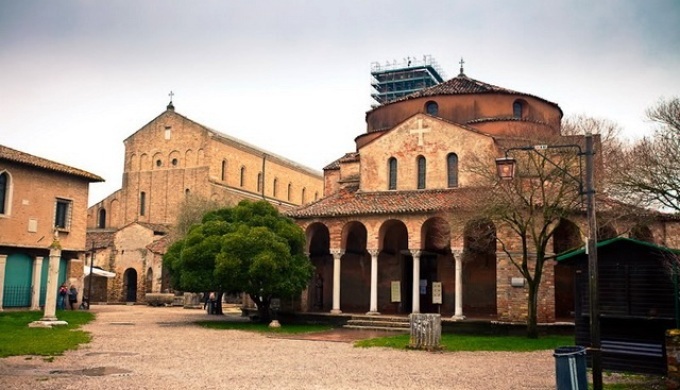 Torcello Island, Venice, Italy
Torcello Island, Venice, Italy The island of San Michele is, in fact, a cemetery. On the Russian lad, the island and the homonymous churchyard bear the name of Archangel Michael, there is also a chapel in his honor here. In San Michele there are the graves of many famous people, including Russians: Diaghilev, Brodsky, Stravinsky, as well as members of eminent noble families who left Russia after the 1917 revolution.
 San Michele Island, Venice, Italy
San Michele Island, Venice, Italy P. Guggenheim Museum is a small collection of early 20th-century art that belonged to Solomon's niece Guggenheim Peggy. In the exhibition there are works by Dali, Modigliani, Picasso, Kandinsky and many others.
 Peggy Guggenheim Museum, Venice, Italy
Peggy Guggenheim Museum, Venice, Italy Rialto Market is the food market of Venice, which has existed for more than 10 centuries. Even if you are not going to buy anything, here it is worth to look for the sake of the atmosphere, excursions among many trays and stalls with all kinds of fish reptiles and local delicacies. Also on the market there are several restaurants, the oldest of which is the Poste Vecie( Poste Vecie) exists since 1500.
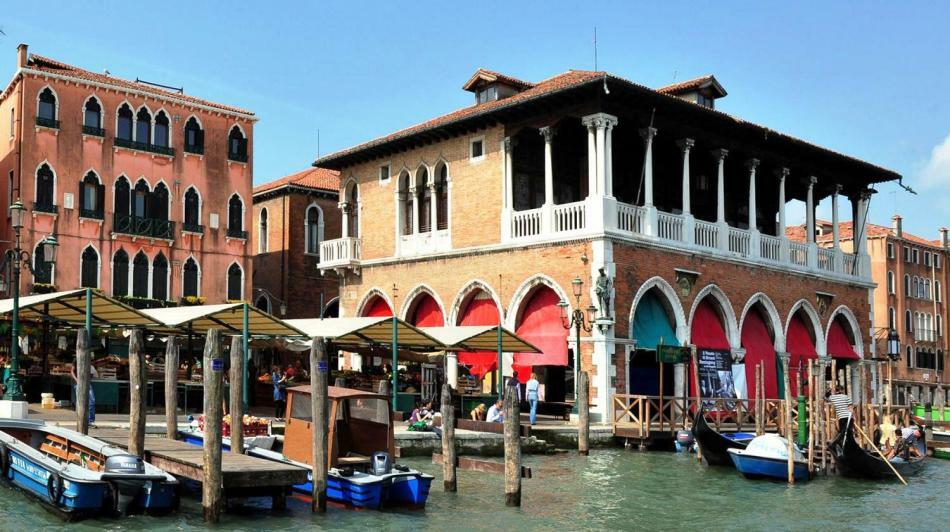 Rialto Market, Venice, Italy
Rialto Market, Venice, Italy Riva degli Schiavoni Embankment is the main promenade of Venice, the name of which translates as "shore of slaves".Since the IX century there was a huge slave market, which, among others, traded Slavs. Nowadays numerous cafes and souvenir shops are located on the embankment.
 Embankment of Riva degli Schiavoni, Venice, Italy
Embankment of Riva degli Schiavoni, Venice, Italy The Cannaregio Quarter is the site where the world's first Jewish ghetto was founded. The old part of the quarter is a medieval city with terribly narrow streets and tiny houses, in which the Jews evicted from the main part of the city huddled. Also, poor townspeople and outsiders were evicted here.
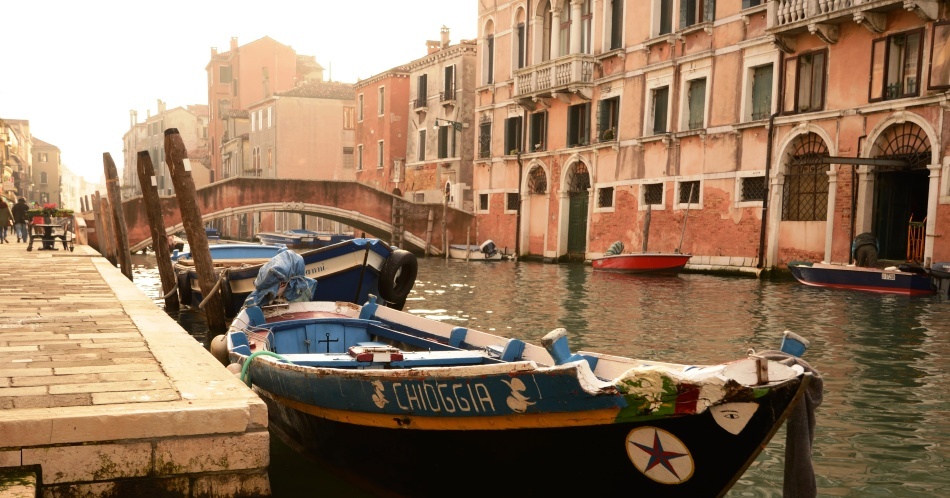 Quarter Cannaregio, Venice, Italy
Quarter Cannaregio, Venice, Italy The islands of San Giorgio and Giudecca - another refuge of exiles and wanderers. On San George for a long time lived Michelangelo, expelled from Florence. These quarters are interesting for their authenticity. There are very few tourists here and the life of ordinary Venetians opens as it is, without a tourist boom and excessive fuss.
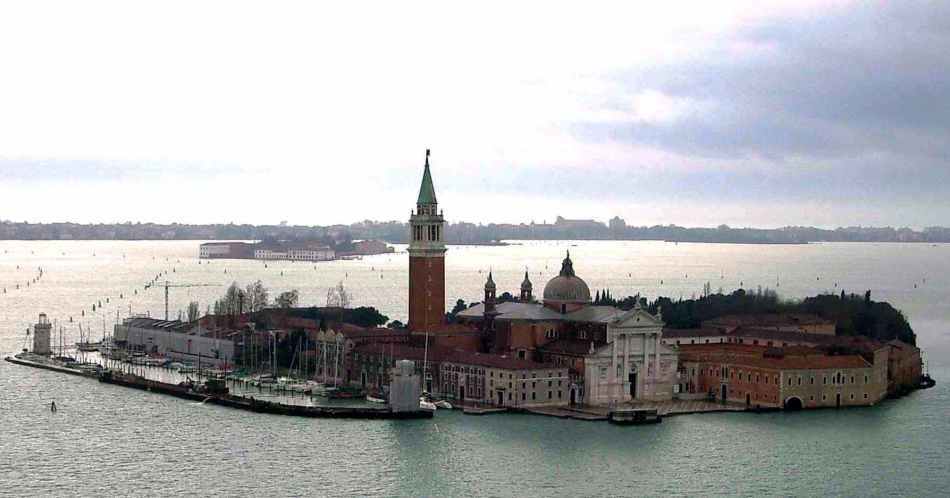 San Giorgio Island, Venice, Italy
San Giorgio Island, Venice, Italy La Merceurie Street is the main place for shopping. There are a lot of boutiques, souvenir shops and handicraft shops, you can buy anything from brand clothes to unique handicrafts. If you are interested in outlets, then shopping should go to the area of Mestre, where there are several modern shopping complexes.
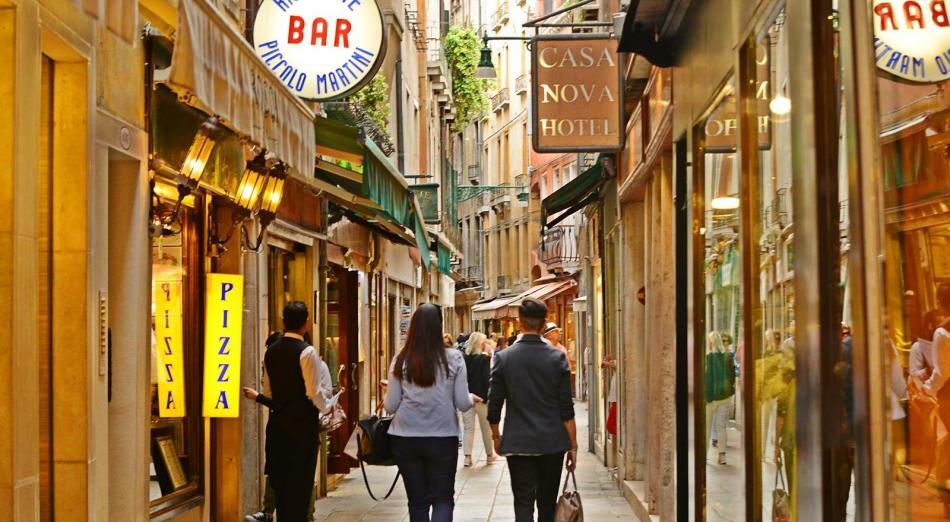 Trade street in Venice, Italy
Trade street in Venice, Italy Map of Venice with all the attractions can be downloaded here
Padua
Padua is located just 40 km from Venice. In Italian, the name of the city sounds like Padova( Padova).Padua is famous primarily for its ancient university, one of the first in Europe( founded in the XIII century).Padua University was, perhaps, the most progressive for its time. It taught astronomy and philosophy Galileo Galilei and Nikolai Kopenik, persecuted by the church for too unconventional views on the world order.
 Padua, Italy
Padua, Italy The first anatomical theater in the world was founded at the University of Padua, and the local faculty of medicine was so advanced that it conducted pathoanatomical experiments.
In those days the dissection was considered a heresy and brutally suppressed by the church. In the 17th century, the first student girl appeared among university students, while in the rest of Europe science remained for a long time a purely masculine privilege.
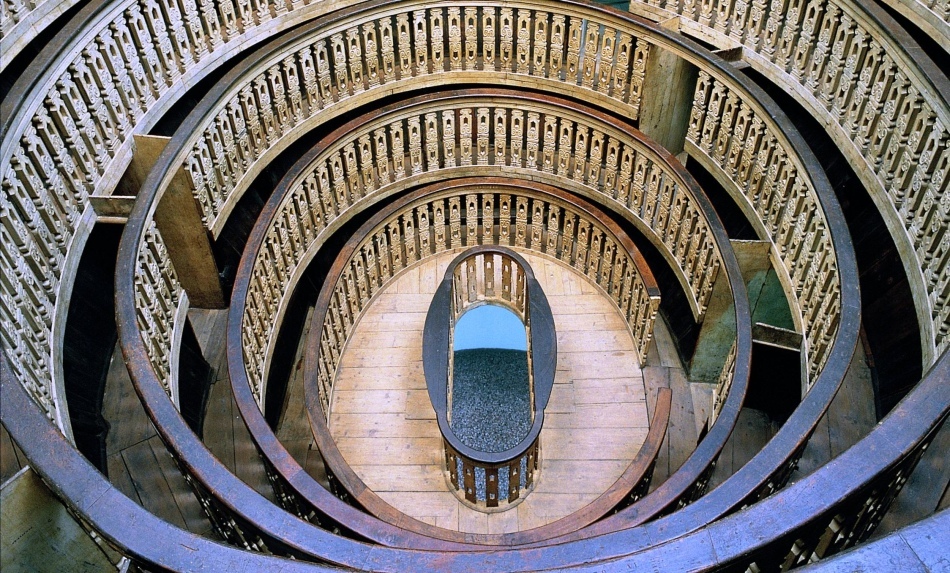 Training audience at the University of Padua, Italy
Training audience at the University of Padua, Italy Another attraction of Padua is the Scrovegni Chapel. The walls of the chapel are painted by the great Italian artist Giotto. The uniqueness of the painting is that the images of the saints were executed for the first time as realistically as possible. In the XIV century, when the chapel was being built, the biblical characters were portrayed as textbook figures sitting in the same pose on the royal pedestals.
 Chapel of Scrovegni in Padua, Italy
Chapel of Scrovegni in Padua, Italy Giotto portrayed them as living people whose faces express emotions, and the figures correspond to the proportions of the human body as precisely as possible.
For that time it was without a doubt a brave act, the first step towards the Renaissance, which will come only 200 years after the death of Giotto. In addition, painting Giotto creates an optical illusion, greatly increasing the small room.
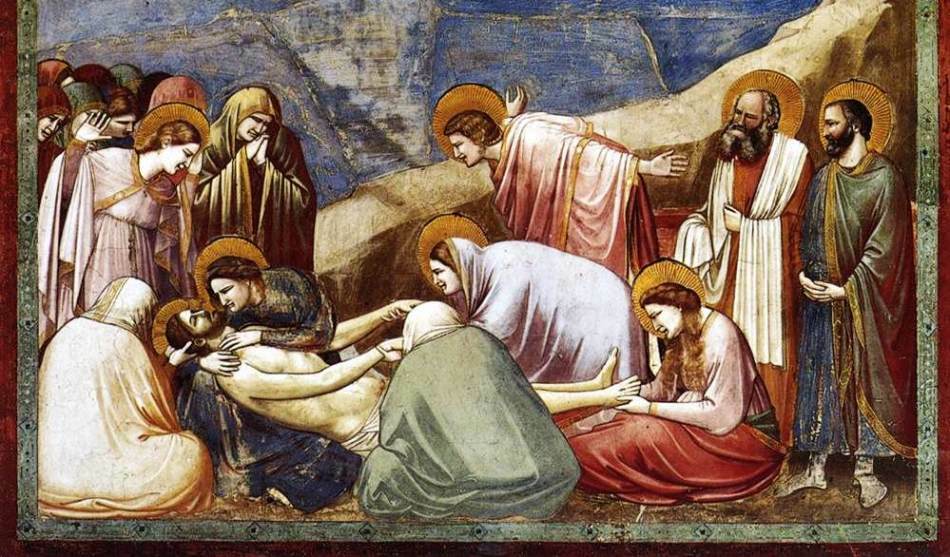 One of Giotto's frescoes in the Scrovegni Chapel, Padua, Italy
One of Giotto's frescoes in the Scrovegni Chapel, Padua, Italy In general, Padua is a very cozy and beautiful city. There is no such tourist boom as in Venice, but quite a lot of interesting places, historical buildings and magnificent views.
Prices in Padua are several times lower in places than in Venice, there are many inexpensive and decent hotels of different star level in the center of the city. Cafes and restaurants are pleased with the quality of service and price tag.
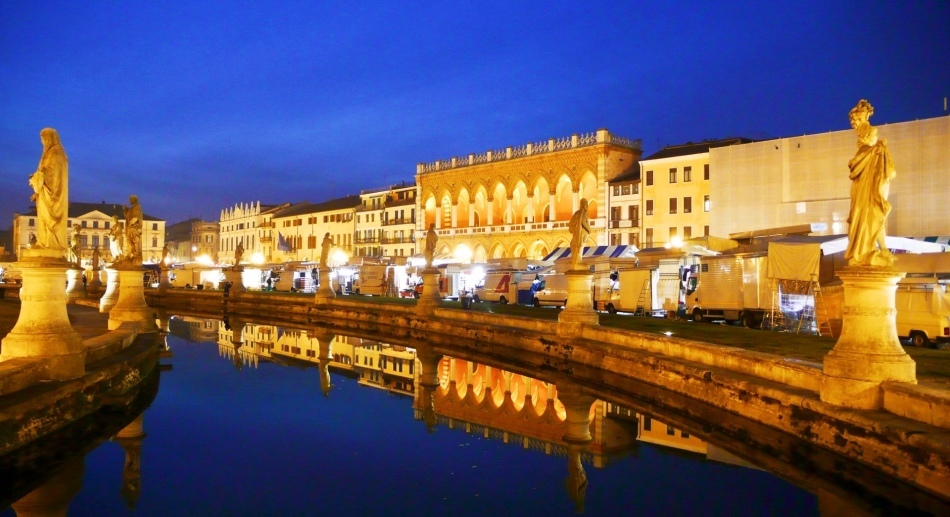 Night Padua, Italy
Night Padua, Italy Padua can be an excellent option for living, if you do not want or can not spend a substantial amount on a hotel in Venice. At any time of the day, just 30 minutes away from Padua to Venice.
Life here is much calmer and more comfortable, the atmosphere is completely different, and the sights and beauties are not less than in other cities of Italy.
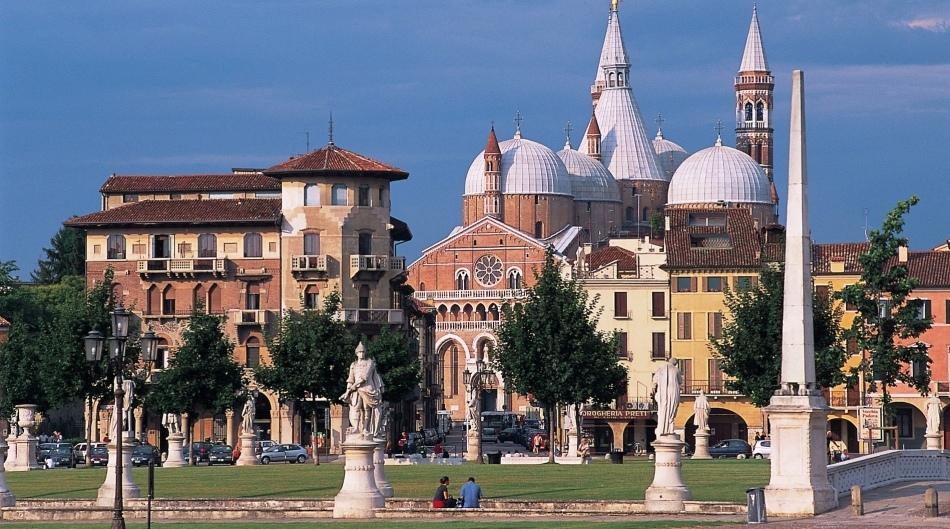 Padua, Italy
Padua, Italy Verona - the capital of all lovers
Verona from Venice is separated by only 120 km of highways. You can get there either by rented car or by public transport - by train or long-distance bus.
 Verona, Italy
Verona, Italy Of course, the main thing for which tourists come to Verona is the house of Juliet and the house of Romeo. The touching story of Shakespeare about two unfortunate lovers is so exciting our minds and hearts that it is difficult to give up the temptation to see the balcony that the young Romeo was climbing to his beloved.
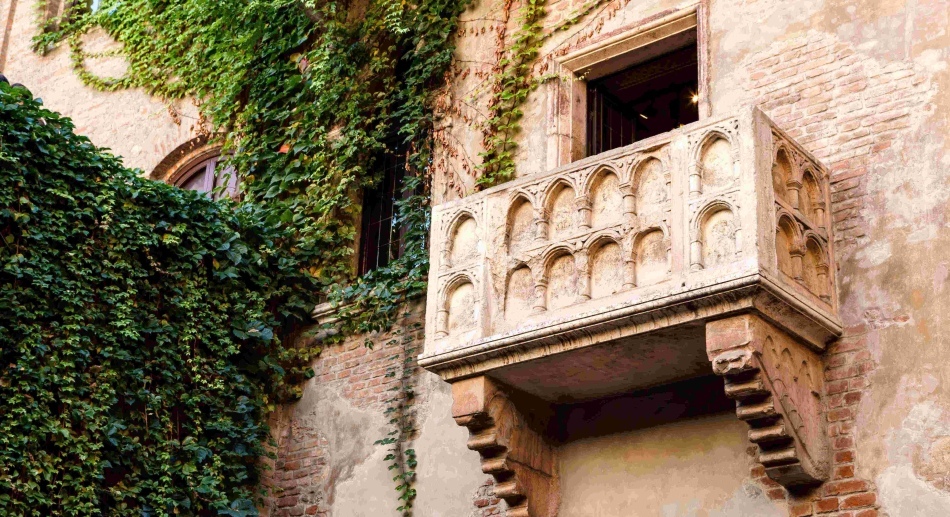 Balcony of Juliet, Verona, Italy
Balcony of Juliet, Verona, Italy For the sake of justice it is worth saying that in reality Romeo and Juliet never existed, Shakespeare invented them. But the prototypes of the families of Capuleleti and Montecchio did reside in Verona, they were at enmity with one another, their houses are now called Romeo's house and Juliet's house( in reality the families bore the names of Del Capello and Monticoli).
 "Romeo and Juliet", a shot from the film F.Dzeffirelli
"Romeo and Juliet", a shot from the film F.Dzeffirelli The house of Montikoli and to this day remains a private possession, closed to tourists, it can only be viewed from the outside. But the family Del Capello has transferred its house to the municipality, and now there is a small museum dedicated to the heroes of Shakespeare. It recreates the interiors of the XVI-XVII centuries, collected ancient costumes, as well as the scenery of several films that were filmed here.
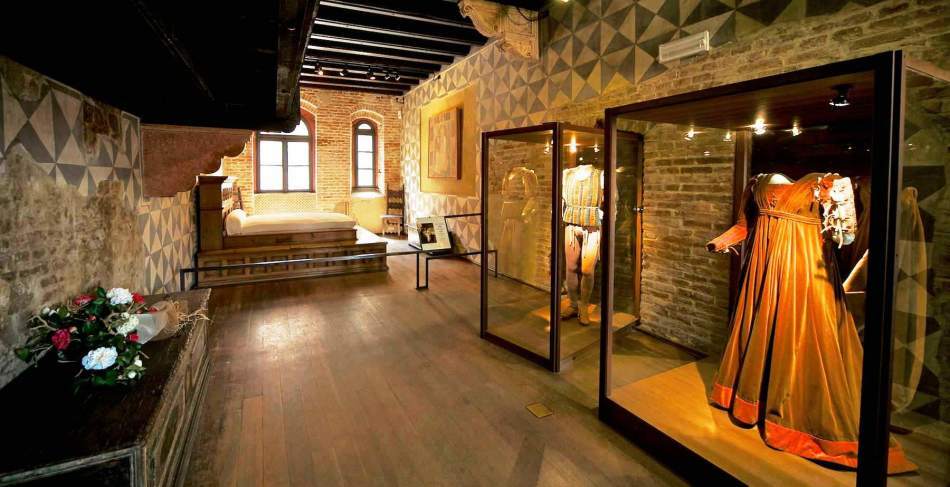 Interior of Juliet's house. Verona, Italy
Interior of Juliet's house. Verona, Italy The house of Giulietta is located at Via Cappello, 23, 37121 Verona, you can enter the courtyard for free at any time of the day, you can get inside the house from 8:30 to 19:30 for 6 euros( on Mondays the museum starts work with13:30).For a fee, you can register for a wedding or a wedding photo session by pre-registration on Juliet's balcony.
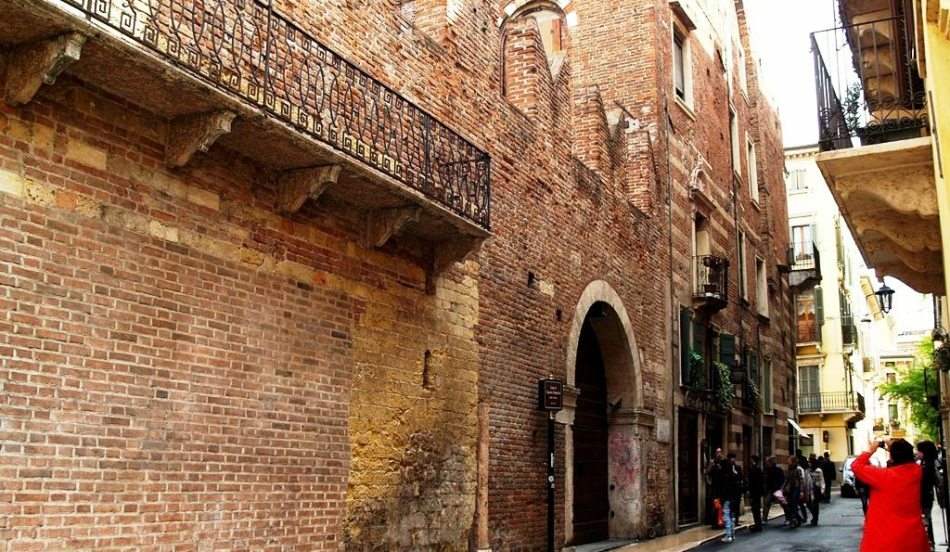 House Romeo, Verona, Italy
House Romeo, Verona, Italy Every year Juliet's house is visited by thousands of lovers to touch the most romantic history of all time. Many leave notes on the walls of the patio and on a hike to the house.
Periodically the local municipality tries to deal with pasted messages, as they seriously damage the appearance and walls of the historic building. But tourists with enviable obstinacy are molding more and more new leaves.
 Notes on the walls of the arch near the house of Juliet. Verona, Italy
Notes on the walls of the arch near the house of Juliet. Verona, Italy Another object of worship that delivers a lot of trouble to the municipality is the statue of Juliet in the courtyard of the house. It is believed that if you rub your palm with your right breast Juliet, then all the heartfelt desires will come true, and the beloved will be with you forever. The right chest of the statue is so carefully polished by visitors that several times the sculpture had to be taken for restoration.
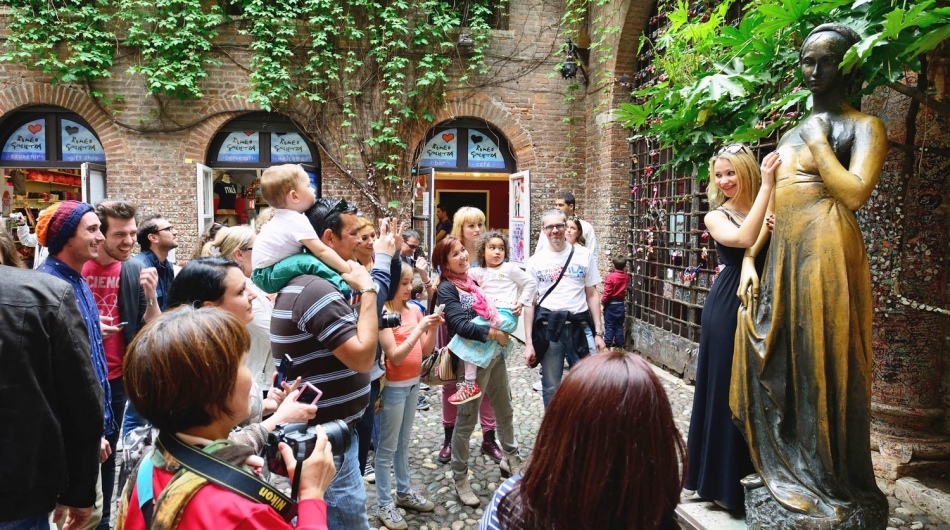 Tourists near the statue of Juliet. Verona, Italy
Tourists near the statue of Juliet. Verona, Italy The "Juliet Club" was created at the museum, in which volunteers write responses to messages left to tourists from around the world. The team is international, so the answer comes in the native language. You can send Juliet's letter from anywhere in the world to the address of Club di Giulietta, Corso Santa Anastasia 29, 37121 Verona Italia, or electronically via a special form on the club's website.
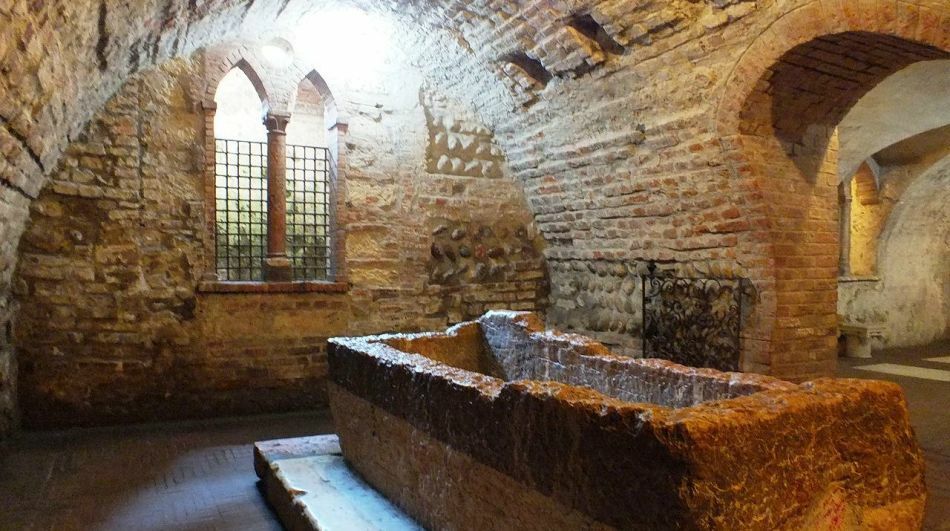 Here, according to legend, Romeo and Juliet were killed. Monastery of the Capuchins, Verona. Italy
Here, according to legend, Romeo and Juliet were killed. Monastery of the Capuchins, Verona. Italy Another place in Verona is associated with the name Juliet - a Capuchin monastery, where, according to legend, young people were married, and in the basement of which the final tragedy of the play was played. You can find the monastery at Via del Pontiere, 35, 37121 Verona, the entrance costs 4.5 euros. Tourists constantly write notes near the tomb of Juliet, and if there is a return address, the Capuchin monks will certainly respond to the message.
